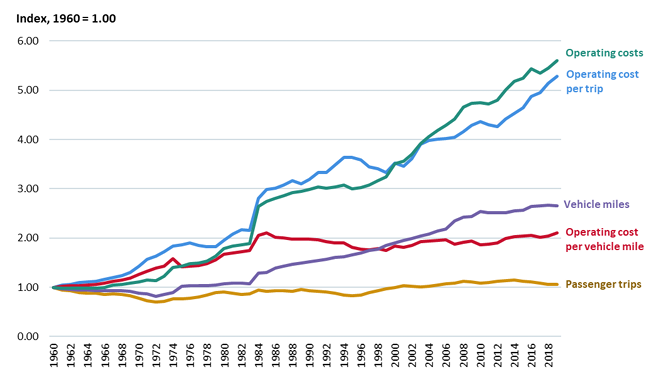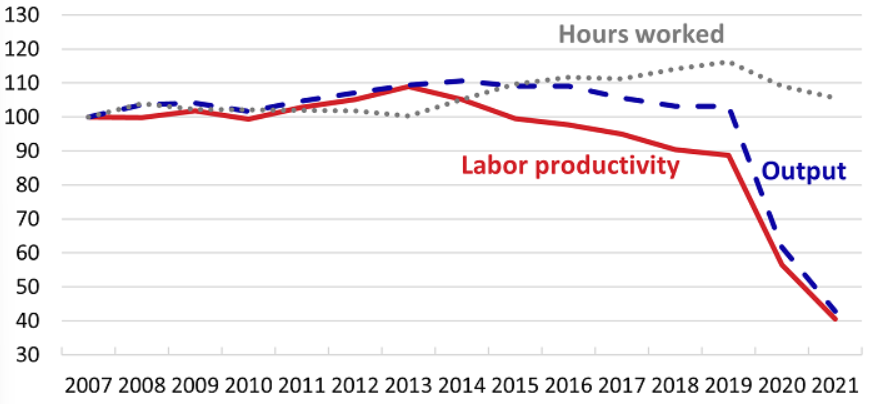Outdated federal law prevents transit automation by preventing the elimination of unneeded (unionized) workers.
Mass transit ridership in the United States cratered during the COVID-19 pandemic and has only been able to recover 74% of its 2019 riders. Despite moving far fewer people, transit costs have continued to rise. But even before the pandemic, the growth in transit operating costs and the failure to control them had plagued the industry for decades.
Recent research finds that automation technologies widely in use outside the United States could dramatically reduce transit operating costs. But unless an outdated federal labor law known as Section 13(c) is repealed, transit agencies will struggle to implement automation and reduce expenses.
Until the 1960s, most mass transit systems in the United States were privately owned and operated. Rising automobile ownership and suburbanization following World War II led to a sharp decline in ridership and a wave of transit company bankruptcies. Congress responded with the Urban Mass Transportation Act of 1964, which created the Urban Mass Transportation Administration (now the Federal Transit Administration) and provided new funding for state and local governments that were taking over bankrupt transit companies.
Section 13(c) of the Urban Mass Transportation Act requires local agencies accepting federal transit grants to implement certain protections for existing employees. The reasoning at the time was that governments tended to be much more hostile to organized labor than the private sector. Union backing was critical for passage, and Congress wrote Section 13(c) to gain their support.
As a result, in exchange for federal funding, transit agencies are required to adopt “protective arrangements” to be certified by the Department of Labor, including:
- The preservation of rights and benefits of employees under existing collective bargaining agreements;
- The continuation of collective bargaining rights;
- The protection of individual employees against a worsening of their positions in relation to their employment;
- Assurances of employment to employees of acquired transit systems;
- Assurances of priority of reemployment of employees whose employment is ended or who are laid off; and
- Paid training or retraining programs.
This historical rationale for these labor requirements no longer reflects reality. Today, 42% of local government employees and 32% of state employees are unionized, compared to only 6% of private-sector workers. Public-sector unions are among the most politically powerful groups in the United States and often exert outsized influence in the dense, urban areas where the vast majority of mass transit ridership occurs.
But Section 13(c) remains in place, freezing transit systems and assumptions about labor relations in the 1960s. In the present, Section 13(c) primarily serves as a deterrent to innovation in transit operations.
It has also occasionally been wielded as a political cudgel, such as when the Biden administration’s Department of Labor attempted to block $12 billion in transit grants to California in 2021 as punishment for modest public employee pension reforms made in 2013. The courts ultimately sided with California, but the message was clear: Cross public-sector unions and risk losing federal transit funding in the future—and the government has a long memory.
Locking in the status quo from 60 years ago has been costly. As Figure 1 from the Congressional Research Service shows, mass transit in 2019 moved about the same number of people as it did in 1960, but transit agencies’ inflation-adjusted operating costs increased by a factor of five. Per-rider costs have only grown even further since the pandemic.
Figure 1: Measures of Productivity in Public Transportation, 1960-2019

Source: Congressional Research Service (2024)
In 2018, the Bureau of Labor Statistics (BLS) began measuring mass transit labor productivity. One important takeaway shown in Figure 2 is that transit labor is insensitive to customer demand for transit service (where output is passenger-miles traveled).
Figure 2: Urban Transit Systems Indexes of Labor Productivity, Output, and Hours Worked, 2007-2021

Source: Bureau of Labor Statistics (2023)
Automation technologies could reduce the operating costs of such a labor-intensive industry. According to the Congressional Research Service, labor compensation accounts for approximately two-thirds of transit operating costs.
The most promising technologies are fully automated systems that eliminate the role of the onboard human driver, which in the rail context is known as Grade of Automation Level 4 (GoA 4) or unattended train operations.
GoA 4 technologies are already deployed on dozens of urban rail transit lines globally. Implementation has been most common in newly constructed facilities, but conversion of existing rail transit lines to GoA 4 is feasible, albeit more complex and costly.
As of Dec. 2023, 39% of U.S. mass transit trips are by high-capacity metro rail, most notably the New York City Subway. Drawing on experiences with GoA 4 metro rail systems in Copenhagen and Vancouver, a recent federally funded study from the C2SMARTER research university consortium found that automation could reduce U.S. rail transit operating costs by up to 46%.
To put this in perspective, the authors note that “automation alone could generate an operational profit on the Boston T’s Red, Blue, and Orange Line, as well as the New York Subway, Philadelphia Subway, [San Francisco’s Bay Area Rapid Transit], and Caltrain,” based on pre-pandemic cost and ridership trends. This is likely too optimistic, but the savings could still be very large and worth pursuing.
GoA 4 automation is in widespread use in U.S. airport people movers, which aren’t subject to federal transit law. It was also deployed on Honolulu’s newly constructed Skyline elevated light-rail system. Unfortunately, Section 13(c) likely prevents the automation of existing mass transit service in the U.S. where it could have the most impact. As a 1976 report from the Office of Technology Assessment concluded:
[Section 13(c)] allows the elimination of jobs, but only as workers presently holding those jobs retire or vacate the positions for other reasons. Thus, the economic benefits of workforce reduction through automation of an existing transit system may be deferred for a number of years until retraining, transfer, or attrition can account for the displaced workers. Alternatively, direct compensation can be paid to affected workers, eliminating the jobs earlier but at an earlier cost.
Given that deploying automation requires transit agencies to either incur substantial upfront costs to pay off affected employees or delay the realization of labor-saving benefits, transit agencies largely dependent on annual government appropriations face a high barrier to investing in automation that would improve service and reduce growing operating subsidies.
To be sure, eliminating Section 13(c) will not automatically usher in the automation of large U.S. rail transit systems. This choice will ultimately be up to transit agencies, and they will undoubtedly face resistance from employee unions. But Section 13(c) is designed to restrict transit management negotiating tactics, so the entire collective bargaining process is distorted to advantage organized labor.
If this outdated labor law were eliminated, agencies would at least have the opportunity to negotiate better contracts that allow for automating existing transit service. Before federal lawmakers consider increasing transit operating assistance, they should examine existing federal policy barriers to transit innovation that prevent local self-sufficiency.
Automation has proven effective at controlling rail transit operating costs outside the United States. For American transit agencies and taxpayers to realize the same benefits, Congress will need to first repeal Section 13(c), presently codified at 49 U.S.C. § 5333(b).











